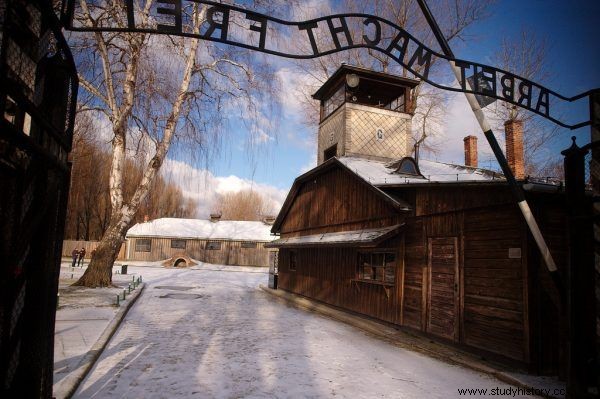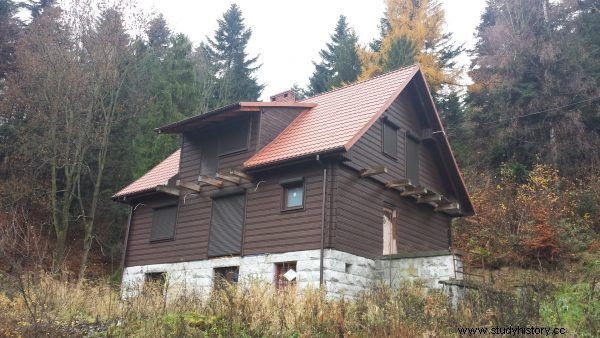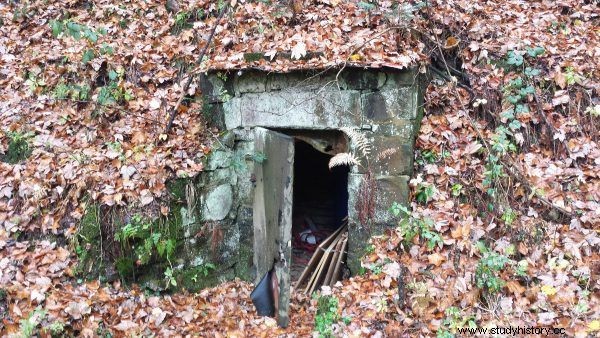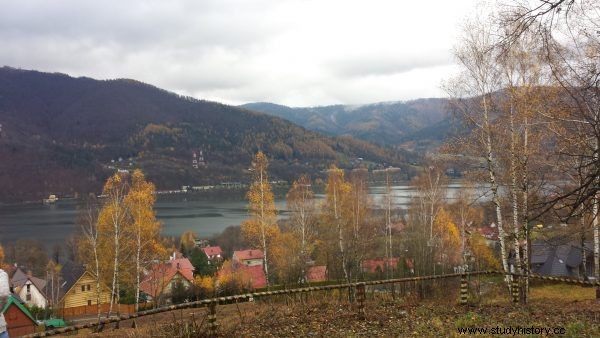Auschwitz-Birkenau. A place of suffering, murderous work and extermination of over a million people. Several dozen kilometers away, in a picturesque town, there was a holiday resort for the camp elite of the SS. Have you ever wondered how the overseers of the Auschwitz death plant rested?
The history of the boarding house for SS officers and their SS-Helferinnen (also called SS-Maiden) female auxiliary service from Auschwitz-Birkenau saw the light of day in 2007 after the United States Holocaust Memorial Museum disclosed photos of an album called "Höcker's Album".
The collection of photos found by an American intelligence officer in Frankfurt in 1945 aroused great curiosity. It contains 116 black and white photographs from the life of German personnel, incl. camps in Oświęcim and Brzezinka. Over thirty of them present relaxation, fun and singing taking place 32 kilometers from the place of torment . The alleged author of all the photos is the former adjutant of the commandant of KL Auschwitz, SS-Obersturmführer Karl Höcker.
Bored SS men
The "Solahütte" (SS-Sola Hütte) center with the villa was located in Międzybrodzie Bialskie, on the Międzybrodzkie Lake and the Soła River, from which it got its name. Even then, the surroundings were often visited and captivated tourists. SS officers took a liking to this nearby town. Without a vacation, they could come to one-day feasts, integration Cameradschafts and dancing parties in a restaurant in the village center. Soon the inhabitants were to be displaced and replaced by Volksdeutsche.

The torturers from Auschwitz were resting only 32 km from the camp (photo:Bill Hunt, CC BY 2.0).
Why are these pleasant moments so short? - the SS officers probably thought. Rudolf Höss, "Angel of Death" Josef Mengele, Josef Kramer and others wanted to stay by the water for at least a few nights. There was also a problem in the form of bored (sic!) SS men getting drunk in pubs in front of Poles. It was decided to build a holiday center in Międzybrodzie Bialskie. It was supposed to stand on the Kotelnica hill, which offers a wonderful panorama.
Arbeit, arbeit…
The view of the external Arbeitskommando under KL Auschwitz is inscribed in the picturesque mountain landscape. The first twenty prisoners were brought to the scene by cars in October 1940. They unloaded building materials and prepared the basements of an abandoned house for the new commando "Porombka", whose commandant was the SS- Oberscharführer Franz Hössler .
A few weeks later, forty prisoners (including the well-known pre-war boxer Tadeusz Pietrzykowski) were placed there. Their tasks included excavating gravel, working with stones and wood, creating an access road and working in the quarry, which is said to be the hardest.
The prisoners had to carry materials up the steep slope on their own backs. Working conditions did not differ much from those in the Auschwitz-Birkenau camps. The situation was made worse by the fact that it is a mountainous area with very steep ascents. Local residents tried to help the unfortunate by planting them food on trucks, but it was risky for both the prisoners and the donors.
The locals were moved by the fact that there were hard-working people in the neighborhood, regardless of whether the sun was shining or it was raining all day long. One can only imagine the work of the prisoners in soaked clothes, in the cold and in the wind, wading ankle-deep in the mud with building materials on their backs.
- Sometimes they rested under a huge haystack. The locals put food in the stack for them. That's what my father told me - says Kazimierz Dudek.
Almost like in the Alps
The guesthouse, built in an alpine style, with a beautiful view of the mountains and the lake, had bedrooms and a large playroom where feasted and danced until dawn . On the eastern side, it stood on a stone foundation, and its upper part was made of boards, insulated with pine needles, moss and peat.

Villa in Solahütte, present state (photo:Łukasz Bieniek).
In front of the building there was an oblong paved terrace where officers napped with women amid the singing of birds and the rustle of trees. There was a wooden bridge nearby, as well as a well, a water intake, and a swimming pool. Officers could also purchase small items in the organized canteen.
The villa, standing to this day on a high stone foundation, had walls made of hewn wood. Currently, the building is slightly modernized, it has two floors. Next to it, in the slope, an anti-aircraft bunker was built one of two in this area. The nearby camps were under more and more observation, in the surrounding forests there was also a branch of the Home Army "Garbnik" .
Kellner, Wasser!
The official opening of "Chata nad Sołą" took place on April 21, 1941. Some of the prisoners were sent to Oświęcim, the rest were taking care of the relaxing SS groups. There were several female prisoners working here permanently, who were not closely guarded and not given much attention. They were mainly cooks, maids, and waitresses.

Entrance to one of the bunkers near the center (photo:Łukasz Bieniek).
Finishing works, transport and minor repairs were carried out by small groups of professional prisoners, such as electricians, transported by trucks. Decorative lamps, door handles and handrails were produced for the center in the camp's smithy.
Working in a ready-made boarding house was not the hardest one, but there was also the other side of the coin:being in close contact with people whose fingertips were decisive for a person's fate. Bronisława Kocemba, a resident of Międzybrodzie and a former guesthouse cook, says:
- I'm old and sick. I don't remember much, but I can confirm that Höss has been to Międzybrodzie. He lived in a wooden villa and often took walks in the woods.
Initially, the SS men came by cars for a short break or for fun. With time, some of them began to stay longer, like in a sanatorium. Special buses started to run quickly between the camp and the center, and the fun started while driving.

Panorama from the site of the former center (photo:Łukasz Bieniek).
Wine, women and singing
The rest was made more pleasant by singing to the accompaniment of an accordion, dances, numerous games and feasts. The SS men, accompanied by women and children, would go for walks in the area, picking berries, then relax on comfortable deckchairs and enjoy the taste of forest fruits. It was a peaceful rest with a view of the lagoon, a huge dam, completed in 1937, and the surrounding peaks. The attraction was, among others Góra Żar on the other side of the reservoir, where a gliding training center was opened. Game hunts were organized for the bored, who had few adventures.
As much time as possible was spent outdoors, the guest rooms were quite cramped, dark and neglected by the holidaymakers . According to the commandant's order, SS men from the sentry battalion rested during the week, and from the headquarters of the commandant's office at weekends. One of the non-commissioned officers was always responsible for order, changed every eight or fourteen days. The space was sufficient for a simultaneous stay of thirty patients.
The staff could not afford the slack and comfort. She only had moments of respite at night, when there was no fun at all. During construction, the prisoners slept on the spot in a wooden barrack, later they were housed in two stone bunkers near the center, where hard wooden bunks could be seen long after the end of World War II.
Prisoners in the Auschwitz-Birkenau camp could feel a slight relief from the supervision of the highest-ranking SS men. It happened that they knew about the elite's departure from the camp, but had to remember that their deputies and guards were still on the watch.
What's left?
After the war, "Solahütte" was taken over by the working class and was part of a holiday resort belonging to the Chemical Works in Oświęcim. A stove has been preserved in it, which was also a fireplace in the living room.
At the end of the 1960s, the HPR Kozubnik-Porąbka Leisure and Training House Complex expanded the existing facilities and created a center where you could swim in the pool, dance until morning in spacious rooms and eat in a restaurant. There was also a sauna, a cinema and a hotel for high-ranking people.
The center was accessible to the best engineers and important officials, even the son of Leonid Brezhnev stayed there. In the past and then this lovely place was available to the few.

The area around the former Solahütte resort is as charming today as it used to be (photo:Łukasz Bieniek).
The "Złoty Stok" Tavern was open recently. In the summer of 2011, the building was demolished. To this day, only the villa has been preserved, which stands below the former holiday home. Everything is in private hands.
The enormous contrast between Auschwitz-Birkenau and the Solahütte center located just over 30 km to the south, where there was no end to laughter and fun, is striking. Where someone else deserved a rest…
Bibliography:
- Piotr Setkiewicz, Aussenkommando SS-Sola H ütte , "Zeszyty Oświęcimskie", No. 25, (2009), pp. 183-192.
- Józef Pszczółka, Where did Rudolf Höss rest , "Nad Sołą i Koszarawą", no. 2/249, January 15, 2009.
- "Dziennik Zachodni", November 6, 2006.
- Alfred Korzeniowski, Solahütte , [in:] Beskidia.pl, October 26, 2011 [access:December 30, 2015].
- SS Hütte Porombka , [in:] Auschwitz-Birkenau. Memorial and Museum, [access:30 December 2015].
